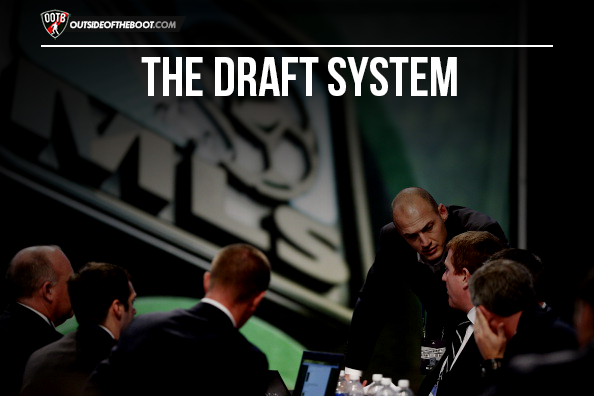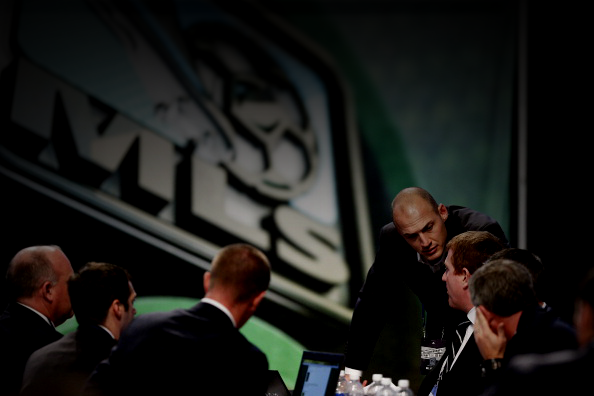Oliver McManus has a look at the pros and cons of the MLS Draft system.
One of my first articles here at Outside of the Boot took a look at the MLS; well, 33 countries later, I’m back and this time I’m going to analyse their draft system.
The draft, it’s very much America personified and remains the only “Americanism” still actively used in Major League Soccer. And, on the face of it, it makes sense – it’s incredibly successful in NFL, NBA and NHL (American football, basketball and hockey for those who unacquainted with American sport).
Many American’s enjoy the drafting system because this means the team they support has a shot at winning it all. This might explain the success of betting platforms like Footstock (for more information read this Footstock review) that provide a much-needed service. Betting allows players to root for their teams with more skin in the game. With a draft, everyone’s team, theoretically, has a chance to win.

The latest draft took place on the 13th January and, like everything in America, it was hyped up as though it were the moon landing all over again. Television coverage on ESPN was extensive and football fans, both hardcore and casual, immersed themselves in the resplendent glory that the Draft, undeniably, is.
There’s a weird affinity for college sports in America, the perception that not only does it enhance your game as a player but also develops you as a person is one shared by many, players, fans and coaches alike.
A key selling point with the Draft is that everyone who has gone through the college system has a chance of being picked up by an MLS club. And, if you think about it, that’s unique in football, in that it allows a direct, concrete route to the professional game.
I say that because, take England for example, inherently it isn’t a level playing field for youngsters – you’re either in the system or not and, if you’re not, you’re not very likely to get a second chance.
In talking about the Draft, you have to talk about the collegiate system because, let’s face it, one cannot exist without the other so. When you look at the players to have progressed through this intertwined system – Chris Wondolowski, for example – clubs aren’t just picking up a good footballer, they’re getting something a bit extra.

Chris Wondolowski in action for the San Jose Earthquakes (Photo by Thearon W. Henderson/Getty Images)
You see, because of the continued education that they receive, oftentimes draft picks can seem more astute mentally – thinking one step ahead, the ability to lead a team from the off. And that can only be a good thing.
Further to that, with the way the Draft works, it actively looks to create a level playing field in the MLS. The worst team of the previous season gets the first pick and so on and so forth – as a result, the teams improve relative to performance. Granted, you can trade picks with other clubs but the principle is the same. It’s almost like Sunderland (for arguments sake) being able to have the first pass on a free agent – no-one else can negotiate until Sunderland say no. Imagine that.
So, we’ve established the purpose of the draft; to both entertain and to actively increase the talent in the league.
On the face of it, the Draft supplies all MLS clubs with access to the world’s biggest youth academy – players based across America (and Canada) all being scouted in the hope that they might be the next big thing. But, as with everything, there are always some drawbacks and, unfortunately, this particular project is rather laden with them.
I don’t like being a naysayer (that’s a lie, I LOVE IT), but there is a distinct reason as to why this format hasn’t been expanded into other leagues – more than just one reason, actually.
The very reason as to why it is so successful in America is the same reason why it will never catch on elsewhere – it is aimed at a capturing interest in what is still the 5th most popular sport in the country. Elsewhere, football is very much established in the fabric of international culture so there is no real need for such an, arguably, trivial occasion.
Likewise, the route to professional football is, as standard, started off at a youth academy and progress though the ranks whilst still learning the trade.
Yes, the MLS is a different level of play but, at the end of the day, the Draft has provided more flops than it has superstars. Freddy Adu, anyone? Need I say more.
The pressure of being first pick can cause a man to crumble. You’re supposed to be the next world beater, that’s how it’s meant to work. But these talents are raw, they’re unfinished, they need nurturing. So, to go in as a teenager and sign your first professional contract with the lights already shining on you, it just heaps on the pressure.
Football being the ruthless game it is, you only need one bad game after having been dubbed the “next Messi” for it all to suddenly spiral out of control. *ahem* Freddy Adu, again.
I like the use of a draft in the NFL. I’ve spent hours trying to predict each team’s pick, it’s captivating. But it doesn’t have the same shazam in the MLS. In NFL, the Draft, essentially, is the only way for a team to pick up young talent. So the tension is heightened.
This isn’t the case in Major League Soccer – sure, the pressure is still there – but clubs have another way of bringing through youth, so they don’t particularly care as much as they, perhaps, should.
In the most spectacular attempt at shooting oneself in the foot since, well, someone actually shot themselves in the foot, the MLS “bosses” decided that each club must affiliate itself with a development team. For their youth players to progress.
Hmmm. So a club can coach a player from the age of, say, 7 to suit the style of play and make sure they get the cream of the crop but, for some reason, they’re expected to fall head over heels about a draft prospect.
Look, I don’t want to be horrible but there is a reason that a footballer is in the collegiate system. More often than not, I’ll bet, it’s because they weren’t good enough to be picked up by an academy.
It’s easy for me to criticise, after all, I did come through the trusted ranks of the Herne Bay Harriers youth teams (heavy sarcasm, in case you weren’t sure). But there is a distinct yearning for change even from those within the game.
You may have read my recent interview with Johnny McKinstry but, if you didn’t, commenting on the Draft/College system, he had this to say;
“I think players (in America), should go through it and, if they make it, fantastic but, in terms of being adopted elsewhere, I think there are challenges that even the soccer fraternity in America would like to update.”
Looking to the future, then, is anything going to change? Well, no is the simple answer. Because of the overall NCAA banner that college soccer comes under (and remember, that is where the drafts talent comes from), the League is, essentially, obligated to provide an opportunity for players to make the step up.
Besides, love it or loath it, it’s here to stay for the foreseeable future. A bit like another controversial topic in the States at the moment – but that’s an entirely different story!
- Syria: The path to World Cup qualification - July 8, 2020
- The story of South Africa’s topsy-turvy footballing journey - November 8, 2017
- Interview: Sunil Chhetri on his foreign stints, Bengaluru FC, and the rise of Indian football - October 24, 2017
























































